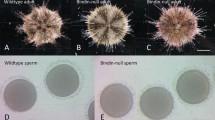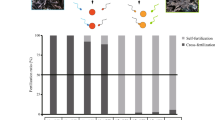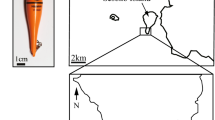Abstract
SPERMATOZOA adhere to eggs during sea urchin fertilisation1,2. The adhesion is between the acrosome process of the sperm and the vitelline layer covering of the egg3. During the sperm acrosome reaction, the membrane of the extending acrosome process becomes coated with protein derived from the sperm acrosome vesicle3,6. We believe4,5, like others3,6, that the acrosome vesicle protein binds the sperm to the egg by interacting with glycoprotein receptors on the egg vitelline layer4,5,7,8. We have isolated the insoluble contents of the acrosome vesicle and have shown it to be composed of a single protein of molecular weight 30,500 which we have named bindin4. In most interspecies inseminations sea urchin sperm fail to adhere to the vitelline layers of foreign eggs and fertilisation does not occur, even though sperm undergo the acrosome reaction in the presence of the foreign eggs9. Presumably this failure of gamete adhesion occurs because bindin, on the sperm acrosome process, does not bind to the glycoprotein receptors on the vitelline layers of eggs of another species. We report here the species specific agglutination of unfertilised eggs by isolated bindin. This demonstrates the preservation of the species specific recognition event between the isolated protein and its receptor which should facilitate the in vitro reconstruction and analysis of the molecular mechanism of gamete adhesion.
This is a preview of subscription content, access via your institution
Access options
Subscribe to this journal
Receive 51 print issues and online access
$199.00 per year
only $3.90 per issue
Buy this article
- Purchase on SpringerLink
- Instant access to full article PDF
Prices may be subject to local taxes which are calculated during checkout
Similar content being viewed by others
References
Tegner, M. J. & Epel, D., J. exp. Zool. 197, 31–58 (1976).
Vacquier, V. D. & Payne, J. E., Exp. Cell Res. 82, 227–235 (1973).
Summers, R. G., Hylander, B. L., Colwin, L. H. & Colwin, A. L., Am. Zool. 15, 523–551 (1975).
Vacquier, V. D. & Moy, G. W., Proc. natn. Acad. Sci. U.S.A. (in the press).
Glabe, C. G. & Vacquier, V. D., J. Cell Biol. submitted.
Dan, J. C. in Fertilization 1 (eds Metz, C. B. & Monroy, A.) 237–293 (Academic, New York, 1967).
Aketa, K., Embryologia 9, 238–245 (1967).
Schmell, E., Earles, B. J., Breaux, C. & Lennarz, W. J., J. Cell Biol. 72, 35–46 (1977).
Summers, R. G. & Hylander, B. L., Exp. Cell Res. 100, 190–194 (1976).
Lowry, O. H., Rosebrough, N. J., Farr, A. L. & Randall, R. J., J. biol. Chem. 193, 265–275 (1951).
Lillie, F. R., J. exp. Zool. 16, 523–590 (1914).
Tyler, A. & Tyler, B. S. in Physiology of Echinodermata (ed. Boolootian R. A.) 683–741 (Wiley, New York, 1966).
Monroy, A., Chemistry and Physiology of Fertilization (Rinehart Holt and Winston, New York, 1965).
Collins, F., Devl. Biol. 49, 381–394 (1976).
Hartman, J. F., Gwatkin, R. B. L. & Hutchison, C. F., Proc. natn. Acad. Sci. U.S.A. 69, 2767–2771 (1972).
Hartman, J. F. & Hutchison, C. F., J. Reprod. Fert. 37, 61–66 (1974).
Author information
Authors and Affiliations
Rights and permissions
About this article
Cite this article
GLABE, C., VACQUIER, V. Species specific agglutination of eggs by bindin isolated from sea urchin sperm. Nature 267, 836–838 (1977). https://doi.org/10.1038/267836a0
Received:
Accepted:
Published:
Issue date:
DOI: https://doi.org/10.1038/267836a0
This article is cited by
-
Sperm tendency to agglutinate in motile bundles in relation to sperm competition and fertility duration in chickens
Scientific Reports (2022)
-
Sperm lacking Bindin are infertile but are otherwise indistinguishable from wildtype sperm
Scientific Reports (2021)
-
Characterization of the Sperm Molecule Bindin in the Sea Urchin Genus Paracentrotus
Journal of Molecular Evolution (2009)
-
Density-dependent regulation of cell growth: An example of a cell-cell recognition phenomenon
The Journal of Membrane Biology (1981)



